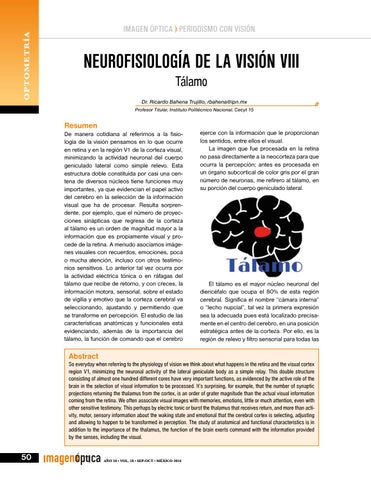OPTOMETRÍA
IMAGEN ÓPTICA )) PERIODISMO CON VISIÓN
NEUROFISIOLOGÍA DE LA VISIÓN VIII Tálamo Dr. Ricardo Bahena Trujillo, rbahena@ipn.mx Profesor Titular, Instituto Politécnico Nacional, Cecyt 15
Resumen De manera cotidiana al referirnos a la fisiología de la visión pensamos en lo que ocurre en retina y en la región V1 de la corteza visual, minimizando la actividad neuronal del cuerpo geniculado lateral como simple relevo. Esta estructura doble constituida por casi una centena de diversos núcleos tiene funciones muy importantes, ya que evidencian el papel activo del cerebro en la selección de la información visual que ha de procesar. Resulta sorprendente, por ejemplo, que el número de proyecciones sinápticas que regresa de la corteza al tálamo es un orden de magnitud mayor a la información que es propiamente visual y procede de la retina. A menudo asociamos imágenes visuales con recuerdos, emociones, poca o mucha atención, incluso con otros testimonios sensitivos. Lo anterior tal vez ocurra por la actividad eléctrica tónica o en ráfagas del tálamo que recibe de retorno, y con creces, la información motora, sensorial, sobre el estado de vigilia y emotivo que la corteza cerebral va seleccionando, ajustando y permitiendo que se transforme en percepción. El estudio de las características anatómicas y funcionales está evidenciando, además de la importancia del tálamo, la función de comando que el cerebro
ejerce con la información que le proporcionan los sentidos, entre ellos el visual. La imagen que fue procesada en la retina no pasa directamente a la neocorteza para que ocurra la percepción; antes es procesada en un órgano subcortical de color gris por el gran número de neuronas, me refirero al tálamo, en su porción del cuerpo geniculado lateral.
El tálamo es el mayor núcleo neuronal del diencéfalo que ocupa el 80% de esta región cerebral. Significa el nombre “cámara interna” o “lecho nupcial”, tal vez la primera expresión sea la adecuada pues está localizado precisamente en el centro del cerebro, en una posición estratégica antes de la corteza. Por ello, es la región de relevo y filtro sensorial para todas las
Abstract So everyday when referring to the physiology of vision we think about what happens in the retina and the visual cortex region V1, minimizing the neuronal activity of the lateral geniculate body as a simple relay. This double structure consisting of almost one hundred different cores have very important functions, as evidenced by the active role of the brain in the selection of visual information to be processed. It’s surprising, for example, that the number of synaptic projections returning the thalamus from the cortex, is an order of grater magnitude than the actual visual information coming from the retina. We often associate visual images with memories, emotions, little or much attention, even with other sensitive testimony. This perhaps by electric tonic or burst the thalamus that receives return, and more than activity, motor, sensory information about the waking state and emotional that the cerebral cortex is selecting, adjusting and allowing to happen to be transformed in perception. The study of anatomical and functional characteristics is in addition to the importance of the thalamus, the function of the brain exerts command with the information provided by the senses, including the visual.
50
AÑO 18 • VOL. 18 • SEP-OCT • MÉXICO 2016
